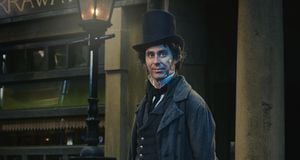Osgood Perkins' latest film, The Monkey, brings to life the vivid imagination of horror writer Stephen King, known for his work spanning decades of page and screen. Adapted from King's 1980 short story, the film carries with it the eerie traits of its inspiration, turning what might have been merely another horror flick on its head by layering humor onto its gory framework.
Set for release on February 21, 2025, The Monkey hops onto the silver screen with Theo James taking on dual roles, portraying twin brothers Hal and Bill, cursed by the unassuming figure of a wind-up monkey toy. Viewers witness the whimsical, drum-bashing toy morph from childhood nostalgia to something far darker as the brothers confront tragedies reinvented by the monkey's bizarre influence.
"Like life," notes the mantra alongside the monkey, signaling the erratic nature of its violent antics which unexpectedly meet out doom upon the unsuspecting townsfolk. Perkins employs both humor and horror —ie, babysitters are decapitated and frantic murders are depicted with absurd exaggeration—to explore the delicious schadenfreude inherent to the horror-comedy genre.
With the collaborative talent of Perkins, the writer/director acclaimed for his previous work Longlegs, and horror aficionado James Wan as co-writer, audiences anticipate exhilarating and shocking moments. Perkins has preferred to infuse levity amid chaos, explaining, "I was hoping to make a comedy with a lot of blood in it." His admission hints at the film's underlying intentions for entertainment laced with dark perceptions of mortality.
Despite excitement over the film's ambitious premise, one notable aspect has left fans pondering: Stephen King himself does not make an appearance. King is famous for the cameos he has made across numerous adaptations and adaptations of his work, but The Monkey seemingly lacks this playful touch. With his glowing review for the film, many were left surprised to not see the horror master partake — especially considering how seamlessly it could have fit within Perkins’ humorous twist on King’s original tale.
King’s absence as both actor and character raises eyebrows, particularly when fans of his work are accustomed to his tongue-in-cheek appearances as pizza delivery men or casual bystanders caught up within the horror fray. His previous moments of comic relief create expectations among the audience. The urge to spot him among the chaos of The Monkey makes his lack of presence more lamentable within the backdrop of amusing yet horrific circumstances.
Critics of the film have expressed mixed feelings on its handling of King’s themes. Some laud its darkly comedic nature, stating the movie's gruesome kills and unexpected levity balance one another exceptionally well. The film has been described as "a sick joke" reflecting the same grandiosity of slasher classics, with innovative depictions of deaths reminiscent of the Final Destination franchise.
"It's a blood bath fit for the Roman waterworks of Caracalla," one critic exclaimed, implying its gory excesses march alongside humorous moments as deaths unfurl. The film’s sheer audacity to intertwine creative violence with comedic flair makes it worthy of recognition, even as others express reservations about the depth behind its humor.
With gory scenes peppered throughout, The Monkey has affirmed Perkins’ appeal as one of contemporary horror cinema’s more unique voices. Adam Scott's prologue introduces the cursed toy humorously through the character's manic desperation to sell it, soon transitioning to the brothers’ tale tainted by their childhood trauma tied to the toy. Perkins makes astute observations, shown through his clever dialogue and directing style, paralleling absurdity and reality.
Perkins is also confronted with the challenge of broadening King’s straightforward narrative arc. Critics argue the film’s doughy pacing and character development could have been strengthened, hinting at moments of similarly flat goofiness, effectively stirring commentary on disparity between humor and horror. Perkins’ fight to balance laughing at misfortune versus feeling sympathetic and apprehensive has faced unfortunate antagonism from those expecting stronger character interactions.
Nevertheless, Perkins has proven capable of weaving together morbid humor and engaging storylines. Perkins’ vision does lead to some laughworthy moments, with bits like "the weed-hazed priest" being callbacks to absurdity, even if it feels disjointed. By placing absurdity alongside chaotic violence, the film showcases its unique tone, compelling viewers to hold on to their boundaries of humor.
The film culminates as Hal matures, dealing with themes of trauma affecting future relationships. Perkins created parallel narratives bound by familial struggle, which both brothers confront differently; Bill seeks to distance himself from their shared past, showcasing Perkins’ human consequences to King’s underlying horror themes. The juxtaposition of humor and horror surfaces reminiscent of traditional King narratives but are layered with modern sensibilities diverging from the original short story.
Whether seen as outright successful or disjointed, The Monkey anticipates amplifying the conversation surrounding horror's adaptability upon the big screen. The emphasis on death humorist reflections asks poignant questions about life perspectives through absurd happenings — as viewers plunge headfirst down the spiral of comedic ballet and bloody fiascos.
With numerous moments sure to elicit laughter, bouts of shock, and remnants of nostalgia amid gory chaos, Perkins’ The Monkey promises to be another entertaining addition to the vibrant roster of Stephen King adaptations — whether the horror maestro himself is present, or not.



